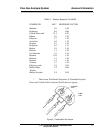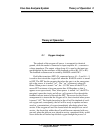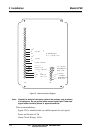
2-4
2 Theory of Operation Model 9700
TELEDYNE BROWN ENGINEERING
Analytical Instruments
An optional CAUTION alarm circuit utilizes potentiometer P4 to
establish the setpoint. When the setting of P4 is exceeded. transistor Q2 is
turned on and relay K1 is energized, resulting in an alarm.
The optional FAILURE alarm circuit is set up so that if the detector
opens up, an alarm comparator will trip and turn off a relay, which is
normally energized, i.e., during the non-alarm condition, the normally
open contact will be closed and the normally closed contact will be open.
The power supply circuitry includes transformer T1 which is a 40-volt
center-tapped unit. Two sets of rectifiers are used to supply two regulated
power circuits and +/-24 VDC unregulated. The circuit that includes Zener
diodes ZD2 and ZD3 supplies +/-15 VDC regulated. Regulator VR2 is the
current regulator for the detector. This regulator is set up so that current
through the detector is determined by resistors R4 and R5. Current output
of 0.3A can be measured at a pair of test points. Capacitor C9, connected
across the input, gives protection from line transients, high voltage spikes,
etc.
2. 3 Detector
The basic elements of the combustible gas detector are shown in
Figure 5. The two beads each consist of a very small coil of wire coated
with an appropriate material. The active (or measuring) bead coating is a
mixture of a catalytic material with an inert binder. This catalytic material
is selected to enhance the oxidation of combustible gases. The reference
bead coating is an inert material having similar thermal properties to the
other bead.
Upon exposure of the detector to an atmosphere containing com-
bustible gases and oxygen, these will combine at the surface of the measur-
ing bead. Energy produced by this reaction will heat the active bead and
cause the electrical resistance of its wire coil to change. The change in
resistance of this coil is, then, for a particular gas, a measure of the reaction
rate at the bead surface. The reaction rate and energy production depend
strongly on the nature of the gas. By raising the temperature of the bead,
the reaction rate can be increased, making the effects of different gases
more nearly equal. Thus, the sensitivity of the detector is made greater and
more nearly equal for different gases. This heating is accomplished by
passing a constant electrical current through the wire coil supporting the
bead.


















